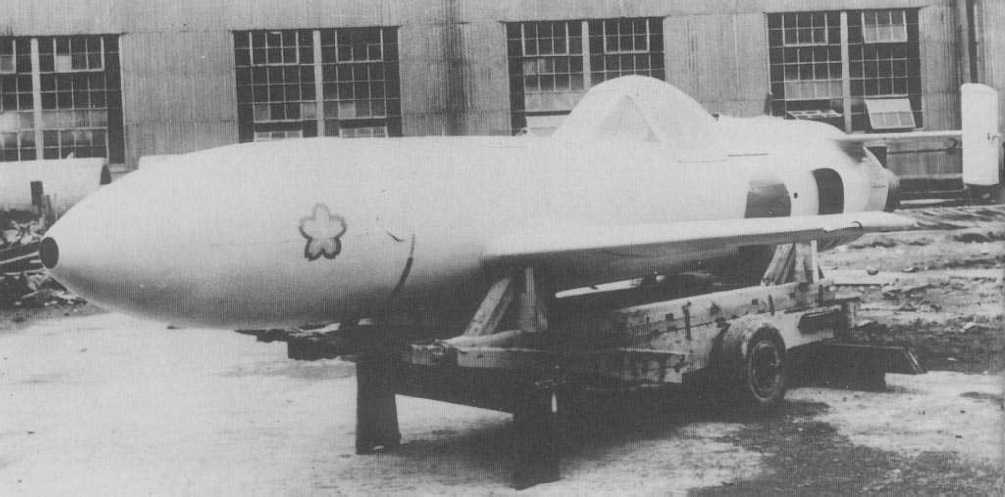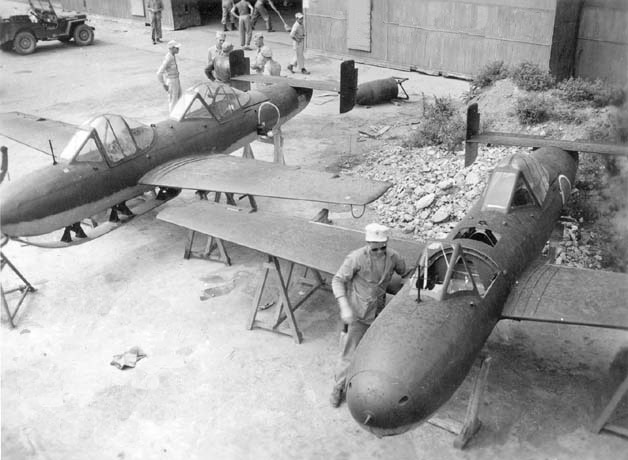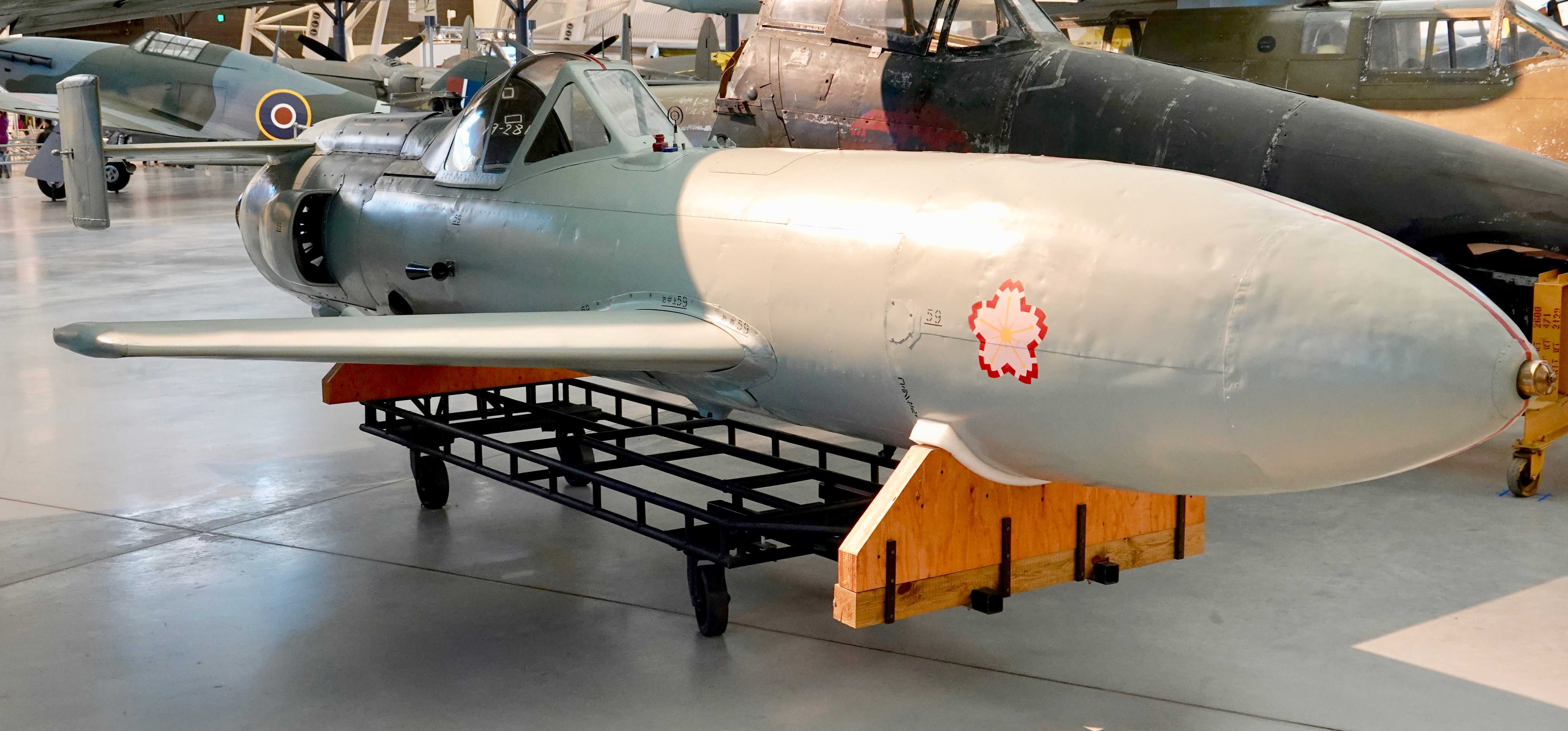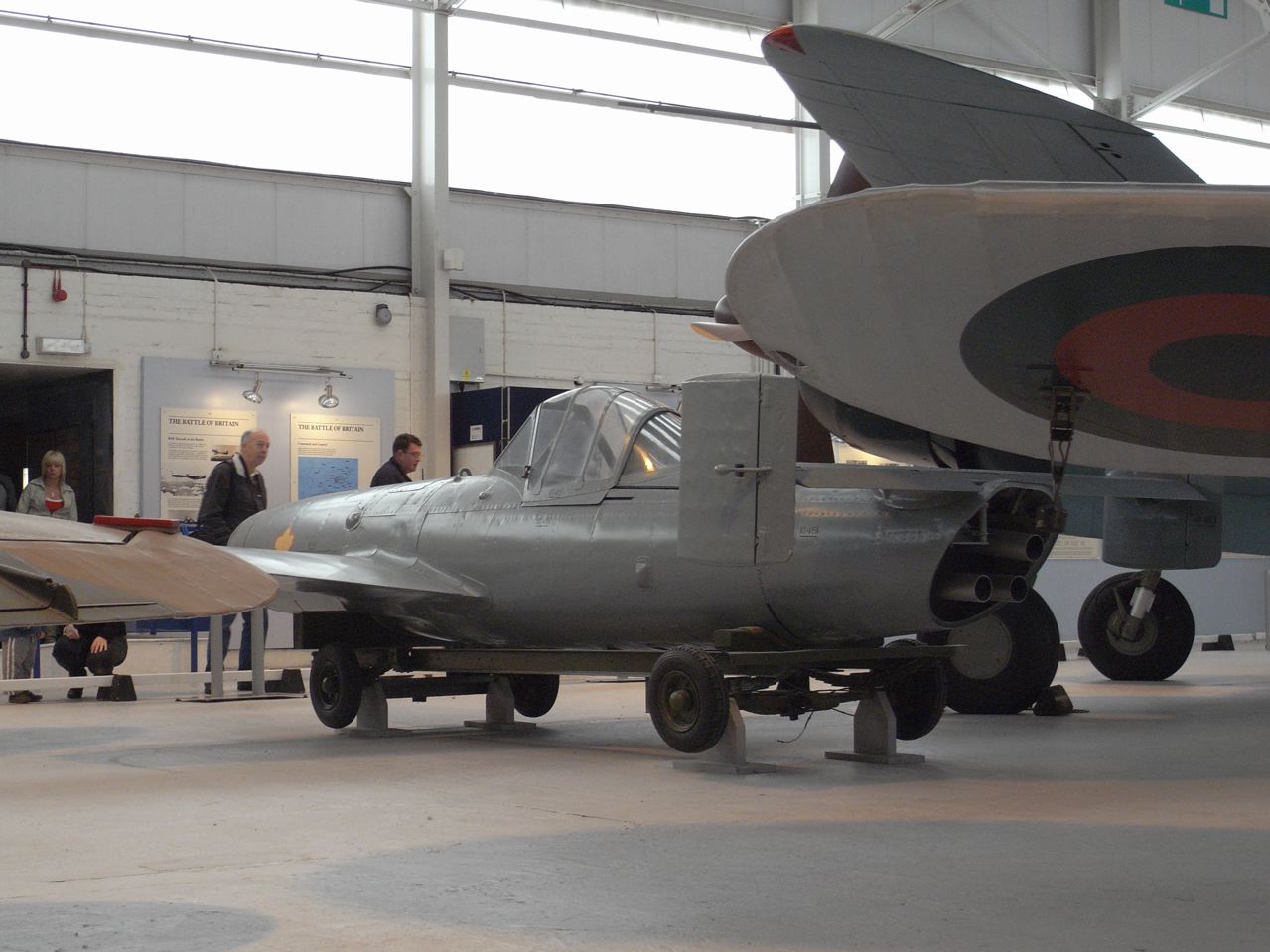Baka Bomb on:
[Wikipedia]
[Google]
[Amazon]
The Yokosuka MXY-7 was a purpose-built,

 The only operational ''Ohka'' was the Model 11. Essentially a bomb with wooden wings, powered by three Type 4 Model 1 Mark 20 solid-fuel rocket motors, the Model 11 achieved great speed, but with limited range. This was problematic, as it required the slow, heavily laden mother aircraft to approach within of the target, making it very vulnerable to defending fighters. There was one experimental variant of the Model 11, the Model 21, which had thin steel wings manufactured by Nakajima. It had the engine of the Model 11 and the airframe of the Model 22.
The Ohka K-1 was an unpowered trainer version with water ballast instead of warhead and engines, that was used to provide pilots with handling experience. Unlike the combat aircraft, it was also fitted with flaps and a landing skid. The water ballast was dumped before landing but it remained a challenging aircraft to fly, with a landing speed of . Forty-five were built by Dai-Ichi Kaigun Koku Gijitsusho.
The Model 22 was designed to overcome the short standoff distance problem by using a
The only operational ''Ohka'' was the Model 11. Essentially a bomb with wooden wings, powered by three Type 4 Model 1 Mark 20 solid-fuel rocket motors, the Model 11 achieved great speed, but with limited range. This was problematic, as it required the slow, heavily laden mother aircraft to approach within of the target, making it very vulnerable to defending fighters. There was one experimental variant of the Model 11, the Model 21, which had thin steel wings manufactured by Nakajima. It had the engine of the Model 11 and the airframe of the Model 22.
The Ohka K-1 was an unpowered trainer version with water ballast instead of warhead and engines, that was used to provide pilots with handling experience. Unlike the combat aircraft, it was also fitted with flaps and a landing skid. The water ballast was dumped before landing but it remained a challenging aircraft to fly, with a landing speed of . Forty-five were built by Dai-Ichi Kaigun Koku Gijitsusho.
The Model 22 was designed to overcome the short standoff distance problem by using a
 ;MXY-7: Rocket powered suicide attacker, unpowered glider prototypes; ten built
;Navy Suicide Attacker ''Ohka'' Model 11: Long designation of the operational attacker
;''Ohka'' Model 11: Suicide attacker powered by 3 × Navy Type 4 Mark 1 Model 20 solid-fueled rocket motors, firing for 8–10 seconds; 755 built
;''Ohka'' Model 21: Suicide attacker, fitted with steel-built wings built by Nakajima; one built
;''Ohka'' Model 22: Suicide attacker, powered by an
;MXY-7: Rocket powered suicide attacker, unpowered glider prototypes; ten built
;Navy Suicide Attacker ''Ohka'' Model 11: Long designation of the operational attacker
;''Ohka'' Model 11: Suicide attacker powered by 3 × Navy Type 4 Mark 1 Model 20 solid-fueled rocket motors, firing for 8–10 seconds; 755 built
;''Ohka'' Model 21: Suicide attacker, fitted with steel-built wings built by Nakajima; one built
;''Ohka'' Model 22: Suicide attacker, powered by an  ;''Ohka'' Model 33: Suicide attacker, powered by an
;''Ohka'' Model 33: Suicide attacker, powered by an


Usashi Heiwa Museum
in Usa, Oita
Baka... Flying Warhead
, ''C.I.C. (Combat Information Center)'', U.S. Office of the Chief of Naval Operations, June 1945.
''Popular Science'',August 1945, ''Japanese Gamble On Human Bombs''
The Mysterious Second Seat – Air & Space Magazine
{{DEFAULTSORT:Yokosuka Mxy7 Ohka 1940s Japanese attack aircraft Kamikaze Parasite aircraft World War II suicide weapons of Japan MXY7 Rocket-powered aircraft Aircraft first flown in 1944
rocket-powered
A rocket-powered aircraft or rocket plane is an aircraft that uses a rocket engine for propulsion, sometimes in addition to airbreathing jet engines. Rocket planes can achieve much higher speeds than similarly sized jet aircraft, but typicall ...
human-guided '' kamikaze'' attack aircraft employed by Japan against Allied ships towards the end of the Pacific War
The Pacific War, sometimes called the Asia–Pacific War, was the theater of World War II that was fought in Asia, the Pacific Ocean, the Indian Ocean, and Oceania. It was geographically the largest theater of the war, including the vast ...
during World War II. Although extremely fast, the very short range of the ''Ohka'' meant that it had to be carried into action as a parasite aircraft by a much larger bomber, which was itself vulnerable to carrier-borne fighters. In action during the Battle of Okinawa
The , codenamed Operation Iceberg, was a major battle of the Pacific War fought on the island of Okinawa by United States Army (USA) and United States Marine Corps (USMC) forces against the Imperial Japanese Army (IJA). The initial invasion of ...
in 1945, ''Ohkas'' were able to sink or damage some escort vessels and transport ships but no major warships were ever sunk. Improved versions which attempted to overcome the aircraft's shortcomings were developed too late to be deployed. Allied
An alliance is a relationship among people, groups, or states that have joined together for mutual benefit or to achieve some common purpose, whether or not explicit agreement has been worked out among them. Members of an alliance are called ...
troops referred to the aircraft as "Baka Bombs".
Design and development
The MXY-7 Navy Suicide Attacker ''Ohka'' was a manned flying bomb that was usually carried underneath a Mitsubishi G4M2e Model 24J "Betty" bomber to within range of its target. On release, the pilot would first glide towards the target and when close enough he would fire the ''Ohka''s threesolid-fuel rocket
A solid-propellant rocket or solid rocket is a rocket with a rocket engine that uses solid propellants ( fuel/oxidizer). The earliest rockets were solid-fuel rockets powered by gunpowder; they were used in warfare by the Arabs, Chinese, Persian ...
s, one at a time or in unison, and fly the missile towards the ship that he intended to destroy.
The design was conceived by Ensign Mitsuo Ohta of the 405th Kōkūtai, aided by students of the Aeronautical Research Institute at the University of Tokyo. Ohta submitted his plans to the Yokosuka research facility. The Imperial Japanese Navy decided the idea had merit and Yokosuka engineers of the Yokosuka Naval Air Technical Arsenal
had many names, each depending on the period of its existence, and the circumstances at that time. Many of the names were acronyms that were derived from its military name or designation, which changed from time to time. The arsenal was sometim ...
(Dai-Ichi Kaigun Koku Gijitsusho, or in short ''Kugisho'') created formal blueprints for what was to be the MXY7. The only variant which saw service was the Model 11, and it was powered by three Type 4 Mark 1 Model 20 rockets. 155 ''Ohka'' Model 11s were built at Yokosuka, and another 600 were built at the Kasumigaura Naval Air Arsenal.
The final approach was difficult for a defender to stop because the aircraft gained high speed ( in level flight and or even in a dive. Later versions were designed to be launched from coastal air bases and caves, and even from submarine
A submarine (or sub) is a watercraft capable of independent operation underwater. It differs from a submersible, which has more limited underwater capability. The term is also sometimes used historically or colloquially to refer to remotely op ...
s equipped with aircraft catapults, although none were actually used in this way. The was the first Allied ship to be sunk by ''Ohka'' aircraft, near Okinawa on 12 April 1945. Over the course of the war, ''Ohka''s sank or damaged three ships beyond repair, significantly damaged three more ships, with a total of seven U.S. ships damaged or sunk by ''Ohka''s.
The ''Ohka'' pilots, members of the ''Jinrai Butai'' (Thunder Gods Corps), are honored in Japan at ''Ohka'' Park in Kashima City, the ''Ohka'' Monument in Kanoya City, the Kamakura ''Ohka'' Monument at Kenchō-ji Zen temple in Kamakura, Kanagawa, and the Yasukuni Shrine in Tokyo.

 The only operational ''Ohka'' was the Model 11. Essentially a bomb with wooden wings, powered by three Type 4 Model 1 Mark 20 solid-fuel rocket motors, the Model 11 achieved great speed, but with limited range. This was problematic, as it required the slow, heavily laden mother aircraft to approach within of the target, making it very vulnerable to defending fighters. There was one experimental variant of the Model 11, the Model 21, which had thin steel wings manufactured by Nakajima. It had the engine of the Model 11 and the airframe of the Model 22.
The Ohka K-1 was an unpowered trainer version with water ballast instead of warhead and engines, that was used to provide pilots with handling experience. Unlike the combat aircraft, it was also fitted with flaps and a landing skid. The water ballast was dumped before landing but it remained a challenging aircraft to fly, with a landing speed of . Forty-five were built by Dai-Ichi Kaigun Koku Gijitsusho.
The Model 22 was designed to overcome the short standoff distance problem by using a
The only operational ''Ohka'' was the Model 11. Essentially a bomb with wooden wings, powered by three Type 4 Model 1 Mark 20 solid-fuel rocket motors, the Model 11 achieved great speed, but with limited range. This was problematic, as it required the slow, heavily laden mother aircraft to approach within of the target, making it very vulnerable to defending fighters. There was one experimental variant of the Model 11, the Model 21, which had thin steel wings manufactured by Nakajima. It had the engine of the Model 11 and the airframe of the Model 22.
The Ohka K-1 was an unpowered trainer version with water ballast instead of warhead and engines, that was used to provide pilots with handling experience. Unlike the combat aircraft, it was also fitted with flaps and a landing skid. The water ballast was dumped before landing but it remained a challenging aircraft to fly, with a landing speed of . Forty-five were built by Dai-Ichi Kaigun Koku Gijitsusho.
The Model 22 was designed to overcome the short standoff distance problem by using a Campini
Secondo Campini (August 28, 1904 – February 7, 1980) was an Italian engineer and one of the pioneers of the jet engine.
Campini was born at Bologna, Emilia-Romagna. In 1931 he wrote a proposal for the Italian Air Ministry on the value of jet pro ...
-type motorjet engine, the Ishikawajima Tsu-11
The Ishikawajima Tsu-11 was a motorjet produced in small numbers in Japan in the closing stages of World War II. It was principally designed to propel the Japanese Yokosuka MXY7 Ohka flying bomb, a kamikaze weapon.
Design and development
The ...
. This engine was successfully tested, and 50 Model 22 ''Ohka''s were built at Yokosuka to accept this engine. The Model 22 was to be launched by the more agile Yokosuka P1Y3 ''Ginga'' "Frances" bomber, necessitating a shorter wing span and much smaller warhead. The first flight of a Model 22 Ohka took place in June 1945; none appear to have been used operationally, and only approximately 20 of the experimental Tsu-11 engines are known to have been produced.
The Model 33 was a larger version of the Model 22 powered by an Ishikawajima Ne-20
The Ishikawajima Ne-20 ( ja, 石川島 ネ-20) was Japan's first turbojet engine. It was developed during World War II in parallel with the nation's first military jet, the Nakajima Kikka.
Design and development
The decision to manufacture this ...
turbojet with an warhead. The mothership was to be the Nakajima G8N ''Renzan''. The Model 33 was cancelled due to the likelihood that the ''Renzan'' would not be available.
Other unbuilt planned variants were the Model 43A with folding wings, to be launched from submarines, and the Model 43B, a catapult/rocket assisted version, also with folding wings so that it could be hidden in caves. A trainer version was also under development for this version, the two-seat Model 43 K-1 Kai Wakazakura (Young Cherry), fitted with a single rocket motor. In place of the warhead, a second seat was installed for the student pilot. Two of this version were built. Finally, the Model 53 would also use the Ne-20 turbojet, but was to be towed like a glider and released near its target.
Operational history
The Yokosuka MXY7 ''Ohka'' was used mostly against U.S. ships invading Okinawa, and if launched from its mothership, could be effective because of its high speed in the dive. In the first two attempts to transport the ''Ohkas'' to Leyte Gulf using aircraft carriers, the carriers and were sunk by the U.S. submarines and . Attacks intensified in April 1945. On 1 April 1945, six G4Ms attacked the U.S. fleet off Okinawa. At least one made a successful attack; its ''Ohka'' was thought to have hit one of the 406 mm (16 in) turrets on the battleship , causing moderate damage. Postwar analysis indicated that no hits were recorded and that a near-miss took place. The transports , , and were also hit by ''kamikaze'' aircraft, but it is unclear whether any of these were ''Ohkas'' from the other G4Ms. None of the G4Ms returned. The U.S. military quickly realized the danger and concentrated on extending their "defensive rings" outward to intercept the G4M/''Ohka'' combination aircraft before the suicide mission could be launched. On 12 April 1945, nine G4Ms attacked the U.S. fleet off Okinawa. The destroyer was hit, broke in two, and sank. destroyed an ''Ohka'' with AA fire 45 m (50 yd) from the ship, but the resulting explosion was still powerful enough to cause extensive damage, forcing ''Jeffers'' to withdraw. The destroyer was attacked by two ''Ohka''s. One struck above the waterline just behind the ship's bow, its charge passing completely through the hull and splashing into the sea, where it detonated underwater, causing little damage to the ship. The other ''Ohka'' narrowly missed (its pilot probably killed by anti-aircraft fire) and crashed into the sea, knocking off the ''Stanly''s ensign in the process. One Betty returned. On 14 April 1945, seven G4Ms attacked the U.S. fleet off Okinawa. None returned. None of the ''Ohka''s appeared to have been launched. Two days later, six G4Ms attacked the U.S. fleet off Okinawa. Two returned, but no ''Ohka''s had hit their targets. Later, on 28 April 1945, four G4Ms attacked the U.S. fleet off Okinawa at night. One returned. No hits were recorded. May 1945 saw another series of attacks. On 4 May 1945, seven G4Ms attacked the U.S. fleet off Okinawa. One ''Ohka'' hit the bridge of a destroyer, , causing extensive damage and casualties. was also damaged by an ''Ohka''s near miss. One G4M returned. On 11 May 1945, four G4Ms attacked the U.S. fleet off Okinawa. The destroyer was hit and suffered extensive damage and flooding. The vessel was judged beyond repair. On 25 May 1945, 11 G4Ms attacked the fleet off Okinawa. Bad weather forced most of the aircraft to turn back, and none of the others hit targets. On 22 June 1945, six G4Ms attacked the fleet. Two returned, but no hits were recorded. Postwar analysis concluded that the ''Ohka''s impact was negligible, since no U.S. Navy capital ships had been hit during the attacks because of the effective defensive tactics that were employed.Kightly, James. "Yokosuka Ohka Kamikaze Pilot." ''Aeroplane'', Volume 39, No. 7, Issue no. 459, July 2011, pp. 30–31. In total, of the 300 ''Ohka'' available for the Okinawa campaign, 74 actually undertook operations, of which 56 were either destroyed with their parent aircraft or in making attacks. The Allied nickname for the aircraft was "Baka
Baka, baká or BAKA may refer to:
Ethnicities and languages
* Baka people (Cameroon and Gabon), an African ethnic group
* Baka people (Congo and South Sudan), an African ethnic group
* Baka language, a dialect cluster of Cameroon and Gabon
* Baka ...
", a Japanese word meaning "foolish" or "idiotic".
Variants
 ;MXY-7: Rocket powered suicide attacker, unpowered glider prototypes; ten built
;Navy Suicide Attacker ''Ohka'' Model 11: Long designation of the operational attacker
;''Ohka'' Model 11: Suicide attacker powered by 3 × Navy Type 4 Mark 1 Model 20 solid-fueled rocket motors, firing for 8–10 seconds; 755 built
;''Ohka'' Model 21: Suicide attacker, fitted with steel-built wings built by Nakajima; one built
;''Ohka'' Model 22: Suicide attacker, powered by an
;MXY-7: Rocket powered suicide attacker, unpowered glider prototypes; ten built
;Navy Suicide Attacker ''Ohka'' Model 11: Long designation of the operational attacker
;''Ohka'' Model 11: Suicide attacker powered by 3 × Navy Type 4 Mark 1 Model 20 solid-fueled rocket motors, firing for 8–10 seconds; 755 built
;''Ohka'' Model 21: Suicide attacker, fitted with steel-built wings built by Nakajima; one built
;''Ohka'' Model 22: Suicide attacker, powered by an Ishikawajima Tsu-11
The Ishikawajima Tsu-11 was a motorjet produced in small numbers in Japan in the closing stages of World War II. It was principally designed to propel the Japanese Yokosuka MXY7 Ohka flying bomb, a kamikaze weapon.
Design and development
The ...
thermo-jet engine with reduced span wings and warhead, to be carried by Yokosuka P1Y1 Ginga
The Yokosuka P1Y ''Ginga'' (銀河, "Galaxy") was a twin-engine, land-based bomber developed for the Japanese Imperial Navy in World War II. It was the successor to the Mitsubishi G4M and given the World War II Allied names for Japanese aircraft ...
bombers. 50 built by the
 ;''Ohka'' Model 33: Suicide attacker, powered by an
;''Ohka'' Model 33: Suicide attacker, powered by an Ishikawajima Ne-20
The Ishikawajima Ne-20 ( ja, 石川島 ネ-20) was Japan's first turbojet engine. It was developed during World War II in parallel with the nation's first military jet, the Nakajima Kikka.
Design and development
The decision to manufacture this ...
turbojet engine, with an warhead, to be carried by the Nakajima G8N1 Renzan
The Nakajima G8N ''Renzan'' (連山, "Mountain Range") was a four-engine long-range bomber designed for use by the Imperial Japanese Navy. The Navy designation was "Type 18 land-based attack aircraft" (十八試陸上攻撃機); the Allied code n ...
bomber
;''Ohka'' Model 43A ''Ko'': Suicide attacker, powered by a Ne-20 turbojet engine, with folding wings, to be catapult launched from submarines
;''Ohka'' Model 43B ''Otsu'': Suicide attacker similar to the Model 43A for catapult launching from caves
;''Ohka'' Model 53: Suicide attacker for aerotow launch, powered by a Ne-20 turbojet engine
;''Ohka'' K-1: Suicide attack training glider
;''Ohka'' Model 43 K-1 : Two-seat suicide attack glider trainer with flaps and retractable skid undercarriage, fitted with a single Type 4 Mark 1 Model 20 rocket motor, for limited powered flight
;"Suzuka-24" (Japanese designation unknown): Alleged interceptor version with warhead replaced by a fuel tank and two 20 mm cannon mounted on top. Supposedly employed at least twice against B-29 formations in April 1945
Surviving aircraft

India
* Model 11 on static display at the Indian Air Force Museum in Palam, New Delhi.Japan
;On display * Model 11 on static display atIruma Air Force Base
is a Japan Air Self-Defense Force (JASDF) base located in the city of Sayama, Saitama Prefecture, north of western Tokyo, Japan.
It was the airfield for the Imperial Japanese Army Air Force Academy until 1945, when it became Johnson Air Forc ...
in Iruma, Saitama
260px, Tea fields in Iruma
260px, Kasumi River in Iruma
is a city located in Saitama Prefecture, Japan. , the city had an estimated population of 147,166 in 66,516 households and a population density of 3300 persons per km². The total area of ...
.
* On static display at the Kawaguchiko Motor Museum
is a museum located in Yamanashi prefecture, Japan. Founded in 1981J-HangarSpace - ...
in Narusawa, Yamanashi
is a village located in Yamanashi Prefecture, Japan. , the village had an estimated population of 3,152 in 1257 households, and a population density of 32.6 persons per km². The total area of the village is .
Geography
Narusawa is located in ...
.
* Model 11 on static display aUsashi Heiwa Museum
in Usa, Oita
United Kingdom
;On display * Model 11 on static display at theFleet Air Arm Museum
The Fleet Air Arm Museum is devoted to the history of British naval aviation. It has an extensive collection of military and civilian aircraft, aero engines, models of aircraft and Royal Navy ships (especially aircraft carriers), and paintin ...
in Yeovilton, Somerset
Yeovilton is a village and former civil parishes in England, civil parish, now in the parish of Yeovilton and District, in Somerset, England, east of Ilchester and north of Yeovil, in South Somerset district. The parish had a population of 1, ...
.
* Model 11 on static display at the Imperial War Museum
Imperial War Museums (IWM) is a British national museum organisation with branches at five locations in England, three of which are in London. Founded as the Imperial War Museum in 1917, the museum was intended to record the civil and military ...
in London.
* Model 11 on static display at the Royal Air Force Museum Cosford in Cosford, Shropshire.
* Model 11 on static display at the Science and Industry Museum in Manchester.
United States
;On display * Model 11 on static display at the National Museum of the Marine Corps in Triangle, Virginia. * Model 11 on static display at thePlanes of Fame Air Museum
Planes of Fame Air Museum is an aviation museum in Chino, California,World Wa ...
in Chino, California.
* Model 11 on static display at the Yanks Air Museum in Chino, California.
* Model 22 on static display at the Steven F. Udvar-Hazy Center of the National Air and Space Museum
The National Air and Space Museum of the Smithsonian Institution, also called the Air and Space Museum, is a museum in Washington, D.C., in the United States.
Established in 1946 as the National Air Museum, it opened its main building on the Nat ...
in Chantilly, Virginia.
* Model 43B K-1 Kai Wakazakura on static display at the Pima Air & Space Museum in Tucson, Arizona. It is on loan from the National Air and Space Museum
The National Air and Space Museum of the Smithsonian Institution, also called the Air and Space Museum, is a museum in Washington, D.C., in the United States.
Established in 1946 as the National Air Museum, it opened its main building on the Nat ...
.
* K-1 on static display at the National Museum of the United States Air Force in Dayton, Ohio.
* K-1 on static display at the National Museum of the U.S. Navy in Washington, D.C.
Replicas on display
Japan
* Model 11 on static display at the Yūshūkan of the Yasukuni Shrine in Tokyo.United States
* Model 11 on static display at the National Warplane Museum in Geneseo, New York.Specifications (Ohka 11)
See also
References
Notes
Bibliography
* Ellis, Ken. ''Wreck & Relics, 23rd Edition'' Manchester: Crecy Publishing Ltd, 2012. * * * Maloney, Edward T. and the Aeronautical Staff of Aero Publishers, Inc. ''Kamikaze (Aero Series 7)''. Fallbrook, California: Aero Publishers, Inc., 1966. * . * * Sheftall, M.G. ''Blossoms in the Wind: Human Legacies of the Kamikaze''. New York: New American Library, 2005. . * Stafford, Edward P. ''Little Ship, Big War: The Saga of DE343.'' Annapolis, Maryland: Naval Institute Press, 2000. . *External links
*Baka... Flying Warhead
, ''C.I.C. (Combat Information Center)'', U.S. Office of the Chief of Naval Operations, June 1945.
''Popular Science'',August 1945, ''Japanese Gamble On Human Bombs''
The Mysterious Second Seat – Air & Space Magazine
{{DEFAULTSORT:Yokosuka Mxy7 Ohka 1940s Japanese attack aircraft Kamikaze Parasite aircraft World War II suicide weapons of Japan MXY7 Rocket-powered aircraft Aircraft first flown in 1944